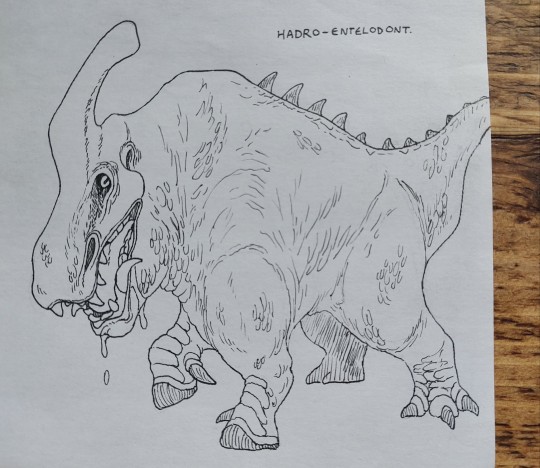Text
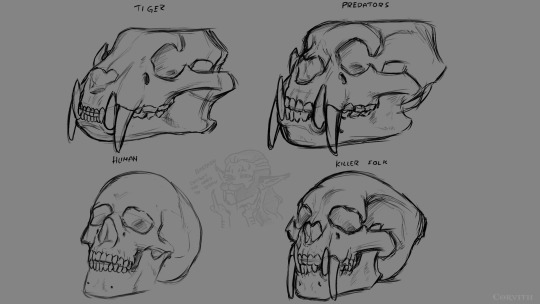

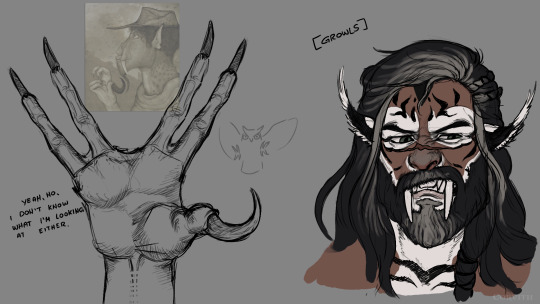
Taking a small break from texture making so I can figure out the anatomy for these gotdam space catboys
I always struggle with the proportions and give them either too human of a face or too much of a snout
130 notes
·
View notes
Text
Its a good day for micro sandwichs made from small bread and chilling

4K notes
·
View notes
Text
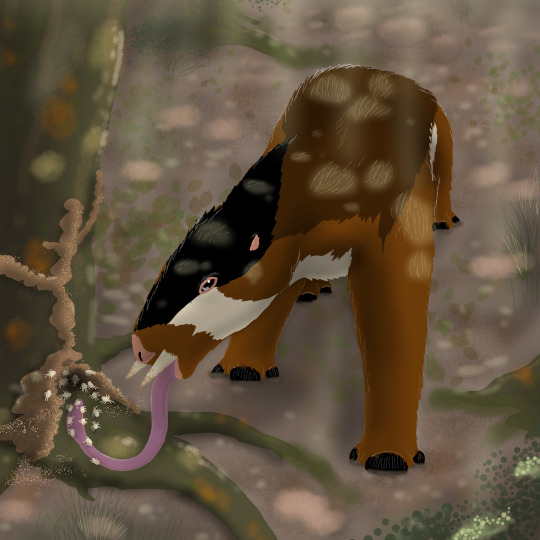
'With the explosion of diversity the hammoths had in the Early Temperocene, on the isolated continent of North Westerna, there emerged many unique forms some of which harkened back to the days of the Glaciocene as giant grazing megafauna, and others, as small burrowers but a tiny fraction the size of their cousins. Yet one unique and aberrant species is neither, a medium-sized forager weighing a generous 40 pounds on average, but nonetheless stands out due to its unusual dietary preferences: the splendid tamandmoth (Myrmecomammuthomys glossomagnus), whose long prehensile tongue, a hallmark of hammoths as a whole that enabled them to graze in spite of immense elaborate tusks some bore in the Glaciocene, now proving equally capable of gathering up wood-boring insects like termites, grubs and beetles exposed from their tunnels by its short, pointed tusks, thus taking advantage of an abundant resource that in this habitat is otherwise rarely exploited. While still grazing on the sparse vegetation of the forest floor and relishing fallen conifer cones on the ground, this atypical hammoth has, perhaps surprisingly, converged with various rattiles, zingos such as the moundhound, rhinocheirids and at one time even specialized hamtelopes in the niche of long-tongued insectivore. Yet this is hardly unexpected as, time and time again, different species unrelated and separated by time and space, arrive upon similar solutions to address a common problem.'
------------
90 notes
·
View notes
Text

one day I’ll get good enough at drawing y aliens to make proper posts about them but for now enjoy my brainstorming of an alien termite that is basically like a walking mushroom that has internal fertilization
151 notes
·
View notes
Text
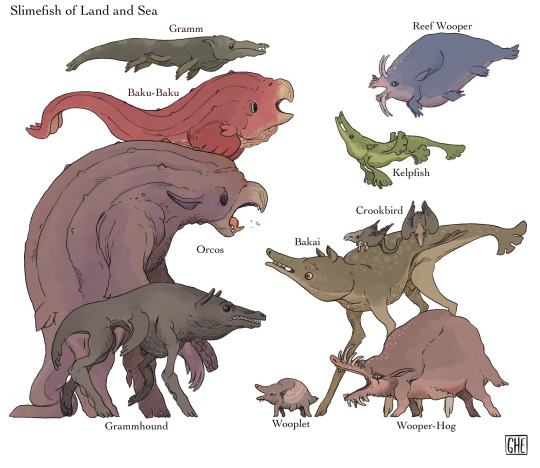
Slimefish of Land and Sea
In the languages of the folks that inhabited Mars eons ago, there was no separation between fish and beast. Instead, there were Slimefish of the Sea, and Slimefish of land, with the creatures like goolas that came out of the sea to mate on the shores somewhere in between. That’s because it is commonly known that the majority of the beasts, walking the surface of Mars were created by Mafa, who changed certain species of fish, for the purpose of it to inhabit growers and planes created by the sponge-wizards, and their teachers — Yulakai.
And so they created bakai – an animal to roam the grasslands and the Forrest ages, eating herbes – like it’s ancestor Kelpfish – that leaved in the Forrest’s of the sea grass using its body shape and colouring to camouflage from predators. The remains of it in a body of Bakai, is it’s til shaped like a leaf of a kelp.
Another herbivore however fearsome creation of Mafa, were the Wooper-Hogs, descendant from the creature known by the inhabitants of the shore regions as a reef-wooper. Their fangs are great to dig through the soil – searching for tasty acorns, and roots. However, they are also great to severely mutilate anybody who comes near their territory or offspring – little wooplets.
Grammhounds as furious as the grammfish are known for hunting in packs, with one giant Alphagramm, surrounded from ten to thirty smaller hounds – right about a half of his size.
The only thing gramms fear is probably orcos – named after the terrible giants from the legend this creature is known to be one of the most furious monsters that inhabit marsian forests and mountain ranges. However mighty orcos is actually descendant from the harmless beings known baku-baku – large animal known to eat only the mollusk known as waternut – for that purpose it developed massive powerful beak – these trait was also taken by their terrifying ancestors…
96 notes
·
View notes
Text

136 notes
·
View notes
Text
Wildlife across the continents of HP-02017 in the Middle Temperocene.
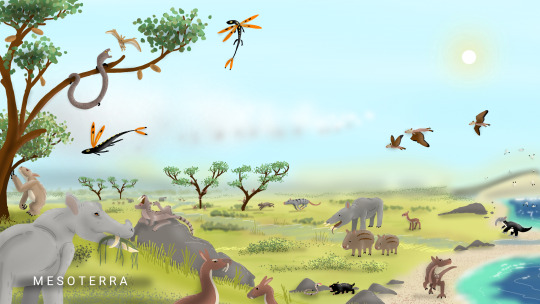

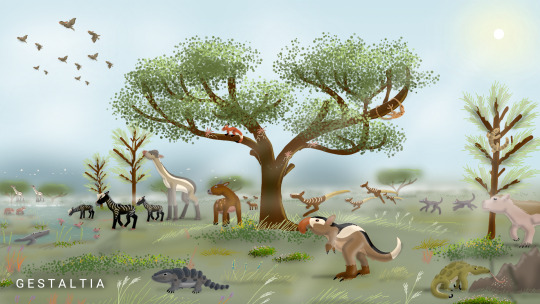

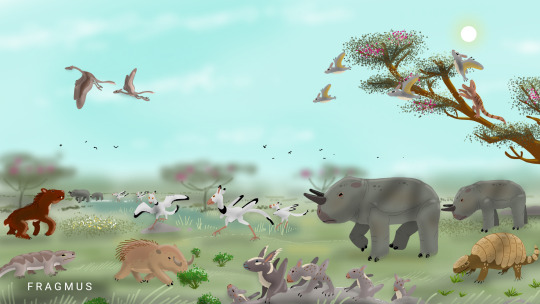


---------
146 notes
·
View notes
Text
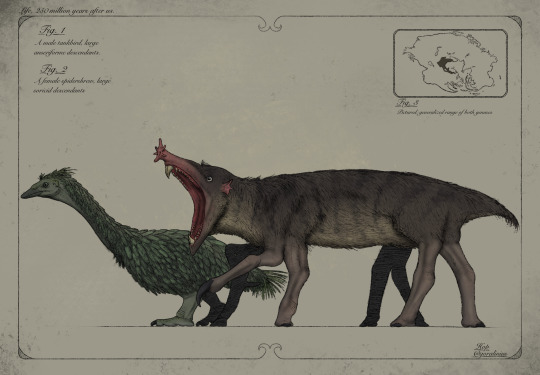
The holocene endotherms, 250 million vears after man has left earth
This is an age very different from ours, one with birds covered in scales like those of pangolins and with small arms, like the very bygone abelisaurs. Mammals
now walk on elongated fingers and extremely atrophied legs, a relic of a day when their ancestors dug through the dirt with swift speed. Lizards fly through the
sky with elongated ribs, catching bizarre fish and insects. Though extraordinary, the age of lizards ended 46 million years ago, with a mass extinction not unlike
that of the great dying.
This is an age like no other.
203 notes
·
View notes
Text

Have had this idea for a seeded world in my mind for a bit now. Here is the general info.
History of the making:
Scylios is an ongoing project where on a seeded planet, fishes, grasses, flowers, slugs, snails and many more species are introduced to experiment with how the planet and animals evolve over time, which is why it is sometimes known as “earth 2.0” as no terrestrial organisms exist at the time of seeding the planet. It is thought that some of the bony and cartilaginous fish will evolve to become terrestrial one day. Will this happen? I hope you follow along on the zoological experience on how the creatures of scylios evolve. The species that get introduced on this planet include a variety of arthropods, molluscs, vertebrates, flowering and non flowering plants and much more. The ancient human civilization died out before they could see how the planet completely evolved. Genetically modified organisms such as small plants and decomposers were the first introduced organisms, used to build an atmosphere and a biosphere where later organisms such as invertebrates, vertebrates and new plants could evolve to thrive on a world only for them. The original state of the new world was very hot and humid, with small forests and big deserts, although this will surely change with time and continental drift. The list of the earliest organisms introduced were;
plants
Dandelion (10+ species)
Waterweeds (2+ species)
Seagrass (20+ species)
Moss (100+ species)
Mushrooms (200+ species)
Daisies (15+ species)
Wild carrots (10+ species)
Bamboo (20+, including Phyllostachys nigra and Phyllostachys bambusoides)
Water lilies (20+ species)
Kelp (5+ species)
Phytoplankton (1000+ species)
Vertebrates
Minnows (10+ species)
Blennies (20+ species)
Anchovy (10+ species)
Wrasse (20+ species)
Rabbitfish (10+ species)
Catsharks (10+ species)
Betta (10+, including alloplesiops altivelis)
Arthropods
Ants (20+ species)
Flies (400+ species)
Scorpions (200+ species)
Spiders (50+ species)
Beetles (100+ species)
Crickets (100+ species
Copepods (200+)
Shrimp (100+ species)
Ladybirds (5+ species)
Annelids
Worms (300+ species)
Leeches (10+ species)
Molluscs
Land Snails (300+ species)
Pond snails (300+ species)
Clams (200+ species)
Land slugs (100+ species)
Sea slugs (100+ species)
Cnidarians (10+ species)
You can see about it on my deviantart! Or reddit.
U/qoralinius
qalasaci
35 notes
·
View notes
Text

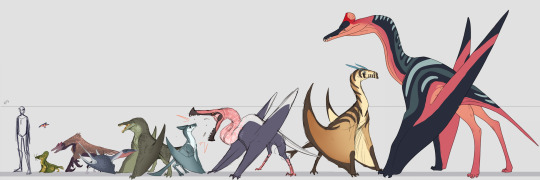
Some species of Mirum Wyverns! Wanted to get a broad grouping because they're very diverse.
Marshy Garfinch- These are barely flighted predators who specialize in wetlands and floodplains. They are more comfortable in the ground and water than flying, but to escape danger they can fly for short bursts. Very chill, will wait patiently for bycatch.
Common Coast Wyvern- Most populous kind, basically a large seagull. They are notoriously bold and fearless, which leads to them stealing food from much larger animals. Most of the time this works out.
Blushing Snapper- Sea going wyverns with a bad temperament. They're known for shrieking and snapping viciously, but tending to flee immediately at the first sign of a physical confrontation.
Pelizard- Basically a lil pelican. They like to bound around the numerous islands around Mirum scooping up fish. On the ground they struggle to walk so they end up hopping along most the time.
Sneck- Another marshland wyvern. One who has completely lost the power of flight. Mostly aquatic they spend pretty much their whole life hiding at the bottom of lake and river beds. Will stick their whole head and neck out to look around.
Galunk- Named for the sound the males make to woo the ladies, these fellas spend most of their time roaming around grasslands. They prefer going after small terrestrial prey which is easy as they are the fastest wyvern on the ground.
Pendulo- Basically a lil hummingbird. They spend their days drinking nectar and catching bugs at breakneck speed. Then at night they sleep by biting and dangling off tree branches. Goofy lil guys.
Rain Chaser- One of the largest wyverns, these guys spend most of the year away at oceanic islands and only return to the mainland during the rainy season. There they like to snack on woodworm eggs for a couple months to fatten up.
False Wyvern- This ones actually a bird.
902 notes
·
View notes
Text

more of my killer folk. thinking of calling them the "psini"
277 notes
·
View notes
Text
Spy's Spec-Bio Essentials
I honestly didn't mean to write a full-on essay, but I couldn't help myself -I love specbio, and the recent revival of interest in it makes me very happy. If you wanna just get right to the meat: normal links are highlighted blue, YouTube links are highlighted red.
Speculative biology has its roots as far back as Pliny the Elder and his Natural History, though most consider H.G. Wells to be the true grandfather of the genre with works such as War of the Worlds, The Time Machine, and Man of the Year Million. However, any speculative biologist worth their salt credits Dougal Dixon as the father of specbio as we know it today –especially since he is the man who coined the term! Dixon's books After Man, Man After Man, and The New Dinosaurs are considered the foundational works of modern specbio. So too is Wayne Barlowe's book Expedition.
While the original printings of these books are very expensive to acquire, After Man recently received a Kindle version, and Expedition has a very good documentary adaptation available in totality on YouTube. Another important work of early speculative biology was the Discovery Channel limited series The Future Is Wild, a documentary show exploring the possible futures of life on Earth in several million years' time.
With the rise of the internet, people interested in speculative biology –those few and far between– could share their thoughts and amateur works with each other. Online specbio hit its first height around the mid-aughts to early tens, featuring many notable works that were very influential to me personally when I joined the scene circa 2014. Unfortunately, right around when I joined there was a notable "mass extinction" –many of the more active and prominent figures of the specbio community left the web behind for various reasons, and thus the golden age ended.
In recent years, partially thanks to certain YouTube video essays on the classic projects, interest in speculative biology seems to have increased dramatically! I've taken to calling the current era the "specbio renaissance," and it makes me so happy to see new, younger people interested in this unique facet of creativity. In light of this I've created this master post of my personal recommendations of essential specbio works for new "speccers" to enjoy!
The specbio community has congregated on forums for decades. I personally joined the community via DeviantArt right around when the old ZetaBoards forum underwent a massive host shift and never participated on the forum all that much, but fortunately the old Speculative Evolution Forum is still up and still active!
For those who'd prefer a simpler way to keep up with current events in the specbio community, Astrovitae is a free e-magazine dedicated to contemporary spec. A product of the recent specbio renaissance, Astrovitae only has a handful of issues thus far but is already becoming a staple publication in the field.
I made this post to provide what I think is key information and important resources, but the SpecBio Wiki is a far more thorough companion to your journey into the world of speculative biology. As always, though: beware ye old Wiki Rabbit Hole!
Biblaridion's Alien Biospheres video series is an excellent entry point for anyone looking to learn the basics of specbio. It's a demo xenobiology project, with a heavy focus on the scientific concepts used in building up the world and its ecology.
Curious Archive's Alien Worlds video series is an excellent collection of bite-size examinations of various specbio projects, including several on this list!
Nemo Ramjet (C. M. Kösemen)'s Life on Snaiad is universally considered a classic work of speculative biology, started in the early days of the golden age of internet specbio. Snaiad is an alien planet, in its early days of human habitation, filled with strange lifeforms bearing two "heads."
Kösemen's other well-known classic work is Alltomorrows, a short ebook exploring hundreds of millions of years' worth of possible human evolution. Readers, be advised: this work contains extensive body horror and discussion of human extinction, both circumstantial and deliberate.
Sagan IV, originally created by Hydromancerx, is one of the oldest and most extensive specbio projects. Started as a simple artistic exercise on a forum in 2006, Sagan IV has evolved into a large, highly collaborative vision of an alien world inspired by the works of Carl Sagan. It is still ongoing today, and you can participate in their regular contests and activities!
Gert van Dijk's Furaha is another of the well-known classic specbio projects, and one of the few from the golden age that is still fully active. Furaha itself is an alien world orbiting Nu Phoenicis which harbors a fascinating native biosphere, built upon carefully-researched biomechanics. The site itself is laid out much like an encyclopedia, and the accompanying blog is a treasure trove of specbio know-how and community history!
Sunrise on Ilion, a xenobiology project by @supermalmoworld, is a personal favorite of mine. Ilion is a planet tidally locked to a red dwarf star, and its endemic lifeforms often challenge our expectations for Earth-like ecology. The website boasts extremely detailed information on the setting and its inhabitants, as well as in-universe articles and logs of the various human expeditions to this fascinating world. The project is still active on a very sporadic basis, at least as per blog entries.
Nereus is a xenobiology project created by Evan Black; another reasonably well-known golden age work but one that is unfortunately no longer active. The world of Nereus, orbiting the star Achird, teems with life unfamiliar to the humans which seek to adopt it as their home. Like many specbio projects it adopts a documentarian style, but there are plenty of nuggets of story tucked in the articles.
Serina is a contemporary speculative evolution project created by the legendary Sheather; it is what I would consider the holotype of the "seed-world" branch of specbio. Serina is a planet populated only by the descendants of the domestic canary (and a few other organisms like guppies, snails, ants, sunflowers, bamboo, algae, etc). The project digs deeply into the various unique niches of the world and the organisms that evolve to fill them, and in doing so mixes nature-documentarian style with some of the most compelling and emotionally engaging storytelling I have read in years.
These are just what I think are the essentials. There are numerous other fantastic projects, both contemporary and from years ago, that I would highly suggest investigating! Contemporary honorable mentions that personally inspire me include @alexriesart's birrin, @iguanodont's birgs, @jayrockin's Runaway to the Stars, Christian Cline's Teeming Universe, Keenan Taylor's Kaimere, and my friend Mičkin's Temere!
122 notes
·
View notes
Text
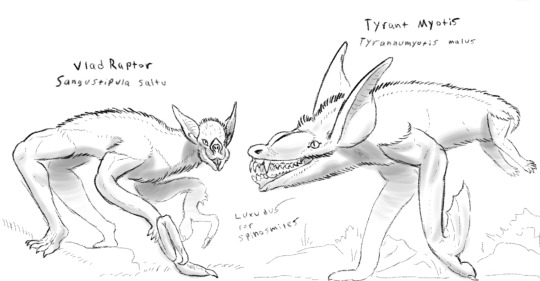
Some Giant Flightless Furious Future Bats i drew almost a year ago, that I tried really hard not to make a bootleg Night Stalker and Future predator but miserably failed. This was for a friend on an old twitter thread where I asked for speculative evolution prompts and she asked for predatory bats
The Vladraptor (Sangustipula saltu) is a quadrupedal descendant of modern day Vampire bats native to what's left of the amazon rainforest some 30 million years into the future. Only 2 of their fingers still have a use. One is flattened out to serve as a pseudo foot while the only other useful finger is highly modified into a Raptorial claw used for swinging at prey. Their hind legs have rotated nearly 180 degrees, allowing it to jump like a grasshopper. It uses what's left of it's echolocation to communicate and coordinate with pack mates to take down the typical Hippo like Capybara descendants or the Fully herbivorous Megafaunal Iguana descendants.
The Tyrant Myotis (Tyrannumyotis malus) is a large, wolf sized descendant of modern day California Myotises native to the west cost of north America some 20 million years into the future. They were able to evolve into such large and ferocious beasts because a small scale extinction event left a power vacuum in the top niches in the local food web. Allowing the unassuming bats to rise to the top. Because of the arid climate of the west cost. A section of their ears and their mostly vestigial wings now serve as heat displacers. Their long snouts had elongated even more to make room for bigger flesh tearing teeth. Forcing their hind body into serving as a counterbalance while their hind limbs atrophied.
66 notes
·
View notes
Photo
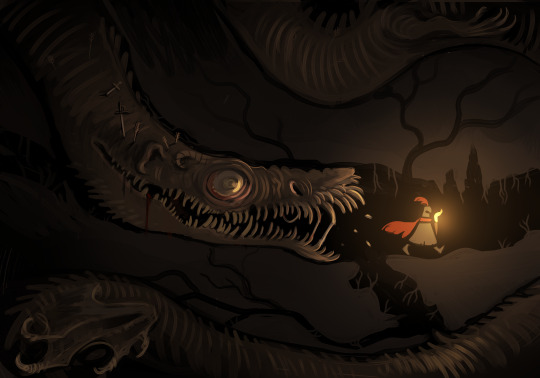
horror game where you play a knight who goes to slay a dragon but you immediately get caved in and have to find your way out of its lair before it tracks you down
29K notes
·
View notes


